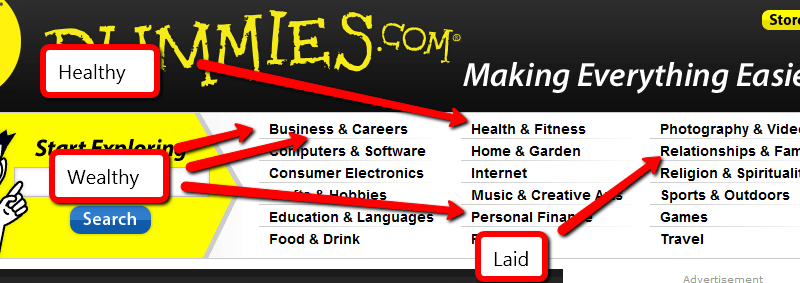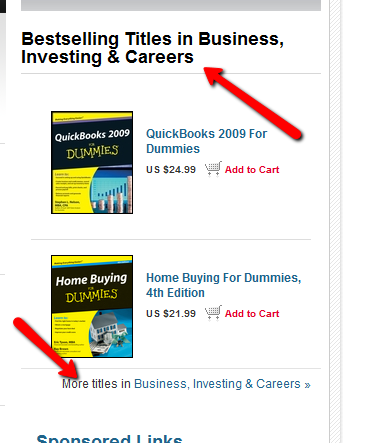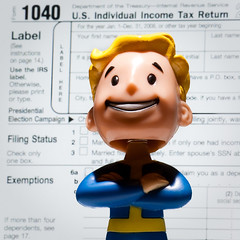This is a conversation between me and my future self, if my financial path wouldn’t have positively forked 2 years ago. The transcript is available here.
What would your future self have to say to you?
The no-pants guide to spending, saving, and thriving in the real world.
This is a conversation between me and my future self, if my financial path wouldn’t have positively forked 2 years ago. The transcript is available here.
What would your future self have to say to you?

If you want to make money, help someone get healthy, wealthy or laid.
This section was quick.
Seriously, those three topics have been making people rich since the invention of rich. Knowing that isn’t enough. If you want to make some money in the health niche, are you going to help people lose weight, add muscle, relieve stress, or reduce the symptoms of some unpleasant medical condition? Those are called “sub-niches”. (Side question: Viagra is a sub-niche of which topic?)
Still not enough.
If you’re going to offer a product to help lose weight, does it revolve around diet, exercise, or both? For medical conditions, is it a way to soothe eczema, instructions for a diabetic diet, a cure for boils, or help with acne? Those are micro-niches.
That’s where you want to be. The “make money” niche is far too broad for anyone to effectively compete. The “make money online” sub-niche is still crazy. When you get to the “make money buying and selling websites” micro-niche, you’re in a territory that leaves room for competition, without costing thousands of dollars to get involved.
Remember that: The more narrowly you define your niche market, the easier it is to compete. You can take that too far. The “lose weight by eating nothing but onions, alfalfa, and imitation caramel sauce” micro-niche is probably too narrowly defined to have a market worth pursuing. You need a micro-niche with buyers, preferably a lot of them.
Now the hard part.
How do you find a niche with a lot of potential customers? Big companies pay millions of dollars every year to do that kind of market research.
Naturally, I recommend you spend millions of dollars on market research.
No?
Here’s the part where I make this entire series worth every penny you’ve paid. Times 10.
Steal the research.
My favorite source of niche market research to steal is http://www.dummies.com/. Click the link and notice all of the wonderful niches at the top of the page. Jon Wiley & Sons, Inc. spends millions of dollars to know what topics will be good sellers. They’ve been doing this a long time. Trust their work.

You don’t have to concentrate on the topics I’ve helpfully highlighted, but they will make it easier for you. Other niches can be profitable, too.
Golf is a great example. Golfers spend money to play the game. You don’t become a golfer without having some discretionary money to spend on it. I’d recommend against consumer electronics. There is a lot of competition for anything popular, and most of that is available for free. If you choose to promote some high-end gear using your Amazon affiliate link, you’re still only looking at a 3% commission.
I like to stick to topics that people “need” an answer for, and can find that answer in ebook form, since I will be promoting a specific product.
With that in mind, pick a topic, then click one of the links to the actual titles for sale. The “best selling titles” links are a gold mine. You can jump straight to the dummies store, if you’d like.
Of the topics above, here’s how I would narrow it down:
1. Business and Careers. The bestsellers here are Quickbooks and home buying. I’m not interested in either topic, so I’ll go into “More titles”. Here, the “urgent” niches look like job hunting and dealing with horrible coworkers. I’m also going to throw “writing copy” into the list because it’s something I have a hard time with.

2. Health and Fitness. My first thought was to do a site on diabetic cooking, but the cooking niche is too competitive. Childhood obesity, detox diets and back pain remedies strike me as worth pursuing. I’m leaning towards back pain, because I have a bad back. When you’ve thrown your back out, you’ve got nothing to do but lie on the couch and look for ways to make the pain stop. That’s urgency.
3. Personal Finance. The topics that look like good bets are foreclosures and bankruptcies. These are topics that can cost thousands of dollars if you get them wrong. I hate to promote a bankruptcy, but some people are out of choices. Foreclosure defense seems like a good choice. Losing your home comes with a sense of urgency, and helping people stay in their home makes me feel good.
4. Relationships and Family. Of these topics, divorce is probably a good seller. Dating advice definitely is. I’m not going to detail either one of those niches here. Divorce is depressing and sex, while fun, isn’t a topic I’m going to get into here. I try to be family friendly, most of the time. Weddings are great topic. Brides are planning to spend money and there’s no shortage of resources to promote.
So, the niches I’ve chosen are:
I won’t be building 9 niche sites in this series. From here, I’m going to explore effective keywords/search terms and good products to support. There’s no guarantee I’ll find a good product with an affiliate program for a niche I’ve chosen that has keywords that are both highly searched and low competition, so I’m giving myself alternatives.
For those of you following along at home, take some time to find 5-10 niches you’d be willing to promote.
The important things to consider are:
1. Does it make me feel dirty to promote it?
2. Will there be customers willing to spend money on it?
3. Will those customers have an urgent need to solve a problem?
I’ve built sites that ignore #3, and they don’t perform nearly as well as those that consider it. When I do niche sites, I promote a specific product. It’s pure affiliate marketing, so customers willing to spend money are necessarily my target audience.

Pre-sale preparation and marketing are important, but ultimately, the money comes from how you manage the sale.
How many people will you have staffing the sale? There are a few considerations here. How many people are involved in the sale? How many people can take the time off? It’s best to have three people at the sale at all times. Two people can manage the money while the third plays salesman and security. Staffer #3 is in charge of watching for price-tag swaps or other theft, answering questions, and trying to upsell. It also allows for breaks, which, if you’ve ever spent a day in a garage drinking coffee, is important.
When are you going to be open? You don’t want to open so early you don’t have time to wake up and get ready for the sale, but you don’t want to open so late the professional garage-salers drive past and forget about you. Plan to open sometime between 7 and 9. When will you close? Staying open until 6 will catch most of the after-work crowd, but it makes for a long day, but closing at four cuts out a lot of the late-day shoppers. Our hours were 8-5, which seemed to be a good compromise between a long day and the best sale.
[ad name=”inlineleft”]Don’t be afraid to shut down. The first day of our sale was cold, wet, and miserable. We had to canopies in the driveway, but everything was getting wet, anyway. Traffic was slow and we weren’t enjoying ourselves, so we shut down. Lunch and a nap improved our outlook considerably. At the end of the day, we start packing up, even if people were there. We tried to only pack what they had looked at, and we didn’t try to rush the potential customers, but we did let them know that the sale was ending for the day. The folks who came in half an hour after close on the last day seemed upset that we didn’t unpack everything for their amusement.
Our layout was designed to get everything easily visible while maximizing traffic. The first day, we were confined to the garage and tents, so space was limited. There were baskets under each of the tables. That forced people to crouch and block each other. The second day, we expanded to fill the driveway. Our tables were organized in 3 rows–a “U” shape with a double-wide row of tables in the middle. This allowed people to see everything in one pass. The middle row had periodic breaks so we could move around to help the customers. The pay table was in the middle of one of the outer rows, which let us monitor the entire sale.
Find someone to watch the kids and pets. If you have to keep an eye on your children, you aren’t watching the customers or giving them the attention they need. Your dog–no matter how well-behaved–is a liability. It will be stressed at the people. Some customers will be allergic or afraid. Just don’t do it.
Ideally, you will have someone who isn’t taking money, knows a little bit about most of the merchandise, and isn’t too shy to talk to strangers. His job is to wander around, answer questions, and help people decide if they want an item. He’s the sales-weasel. If he’s pushy, he’ll chase off the customers, but if he’s hiding, he isn’t making any money. Unusual items should have a sign attached explaining why they are special, so the sales-weasel doesn’t have to explain it to everyone.
Every single item should be priced, but not everything needs to be priced individually. We priced all of the movies in a group. “VHS: $0.50 or 5 for $2, DVD $3 or 4 for $10”. Nobody should have to ask what an item costs. If there are multiple people doing a sale together, make sure everyone is using colored price tags to identify who is selling what.
People come to garage sales expecting to find good deals. If they don’t, they’ll leave. Our rule of thumb for pricing was about 25% of retail, with wiggle-room for the item’s condition. New-in-the-box sometimes made it up to 50% of retail. Our goal was primarily to reduce clutter, so a lot of items were priced at 10%. You have to keep in mind that, if you price things too low, people will assume there is something wrong with it and not assign a value in their own minds. Price it at what you would be willing to pay in a garage sale, then mark it up–just a bit–to account for haggling.
People love to haggle at garage sales. It gives them an opportunity to brag about the great deal they fought for. Try to accommodate them. One of the people participating in our sale was selling antiques with a definite value. She didn’t want to haggle on any prices, so we simply hung up a sign that read “All white-tagged prices are firm.” Everyone else was willing to accept almost any reasonable offer. Our most important rule for accepting a price? If you pissed me off, I didn’t budge on price. Insult me, or offer 1/10 of the price, and my defenses go up, bringing your final price with it. Talk nice and use some common sense while haggling, and you got what you asked for.
[ad name=”inlineright”]Could we have maximized the sale more? Probably. I had intended to hang up a sign that simply said “$100” to set a high anchor-price on everything, but I forgot.
Note: The entire series is contained in the Garage Sale Manual on the sidebar.
Update: This post has been included in the Carnival of Personal Finance.
In April of 2009, I told my wife we were either going to straighten out our finances or file bankruptcy. At that time, we had $90,394 in total debt, including $30,000 in credit card debt. It hasn’t been easy, but we are working out way out of that hole. Since then, we have paid down more than $30,000. That’s not $30,000 in payments, but $30,000 less debt. We are now less than $60,000 in debt. We have entirely stopped accumulating more and I don’t remember the last time we carried a new balance on a card or had to use our overdraft protection. Next month, my car will be paid off, 10 months early.
Given my new-found fanaticism, I spent the next 6 months or so evangelizing about our debt repayment. Eventually, I decided to share my thoughts and progress with the world and launched this site on December 1, 2009. Today is my anniversary.
Here we are, 234 posts, 695 comments, and 17, 661 spam later. You all rock. Except the spammers.
To say thank you, I’m giving away a $100 Amazon gift card to some lucky reader. Yes, I rock, too.
There are several ways you can enter the drawing:
1. Subscribe to Live Real, Now, either by RSS or email. If you are already subscribed by email, you are automatically entered. To show me you have subscribed by RSS, there is a contest code in the feed. Just post that in the comments. (1 entry)
2. Follow me on twitter and tweet the following: “@LiveRealNow is giving away $100. Come get some! Follow and RT to enter! http://bit.ly/f1roKM #Giveaway #Yakezie” (1 entry possible per day. Every day you retweet this is another entry!)
3. “Like” LRN on Facebook. This is easy, just click the little ‘like’ button on the left. If you’ve already done that, you have already entered once.(1 entry)
4. Send me an email at Jason <AT> LiveRealNow <DOT> net telling me what you would like to see me write about more (or less!). You can also use the contact form. (1 entry)
I’m closing this down on the 15th. That’s 18 possible entries for $100 you may win early enough to help with some last-minute Christmas shopping.
UPDATE:
And the winner is…Claudia! Congratulations. Email sent.

 When you are just entering the world of binary options trading or investing, you may be on the receiving end of a lot of advice. It is not uncommon to hear people tell you to implement different gambling strategies because binary options are based on chance more than anything else. You will also hear a lot of advice from those who say there are many good ways to develop an effective strategy using indicators and market signals. Some will insist that with proper analysis of market data, a solid strategy can be developed too.
When you are just entering the world of binary options trading or investing, you may be on the receiving end of a lot of advice. It is not uncommon to hear people tell you to implement different gambling strategies because binary options are based on chance more than anything else. You will also hear a lot of advice from those who say there are many good ways to develop an effective strategy using indicators and market signals. Some will insist that with proper analysis of market data, a solid strategy can be developed too.
Are they all correct? Interestingly enough, the answer is yes. The reason for this is simple, and as one expert writes, “there is no such thing as a perfect strategy for every trader. There is only a best strategy for each individual trader.” Thus, your strategy has to be shaped around a few things:
Identifying the answers to these questions is the first step to formulating a strategy. You should also understand that the winning percentage of most strategies will be somewhat constant, but the total number of successful trades varies on an individual basis and is based entirely on the strategies used.
For instance, some investors want a high percentage of winning trades and are more comfortable with risk averse trading. Others are ready to take more risk and are entirely comfortable winning fewer trades if the returns on winning trades are dramatically higher. This enables them to implement higher risk trades. The interesting thing about strategies and the kinds of trades they generate is that they are all built from the same data.
The Data of Strategy
For example, almost all strategies will look at issues like market trends, trading trends, highs and lows, reversals, and various kinds of indicators. The reason that high and low trends pay off in strategy development is simple: binary options trading applies to whether or not an asset rises above a strike price or doesn’t. It is the proverbial “yes or no” part of the proposition and analysis for either outcome pays off.
As an example, a lot of risk-averse investors will look for breakouts. They use these for trend line investing, which can be as brief as sixty seconds to a day, but can be used to coordinate investing in the direction of a short trend. Although this seems complex, it really is not. The key is that analysis cannot be broad and across all available markets. Instead, focused analysis on a specific area will allow even a novice investor to analyze for a breakout and then invest in binary options accordingly.
Just being able to detect a reversal or a downward trend over the course of a day can yield a very rewarding investment. The key is to understand your strategy based on your budget, personality, and your ability to stick with the strategy, even if it does not yield immediate success. When you do this, and use the right tools for analysis, you can create an effective strategy that brings you closer to your goals.
This is a guest post.

Is the IRS after you? Did you forget to file your tax returns for the last 10 years? Are you worried that they are going to seize your bank accounts, leaving you broke and unable to finance your latest Pokemon acquisition?
There are many reasons people neglect to file their tax returns. None of the reasons are good. The usual reason is that you know you’ll owe money you can’t afford to pay, so you wrap yourself in denial and attempt to delay the inevitable. For future reference, the government always wins. Not filing is a temporary solution at best, and a really bad one at that. Not paying just guarantees that you will owe more penalties than if you had filed and gotten on a repayment plan. Avoiding your tax return will come back to haunt you eventually.
If you haven’t filed your tax returns, you need to do so as soon as possible. The longer you wait, the fewer options you have and the more likely the account seizures. Keep your money under your own control. Another problem with not filing is that the IRS will estimate your tax debt. The estimate is always in their favor. If you file, you get to list your deductions. If you don’t file, they give you the standard deduction and ignore almost everything in your favor. In some cases, this can mean they think you owe $10,000 when in reality, if you file, you will only possibly owe $1500.
To get started, you need to do is call the IRS at (800) TAX-1040. This call serves three purposes.
First, you need to confirm which years you need to file. Simply ask for the last year in which you have filed.
Second, request a transcript of all of your 1099s and W-2s. These are the forms that your employers, investments, and banks have sent to the IRS detailing your income. Over the years, it’s easy to lose paperwork, so this will ensure that you’re records match theirs. Depending on the time of the year, you should have the files in under a week. You’ll get one per delinquent year.
Third, this call gives you a chance to get on the “good debtor” list. You may have to get transferred to the collections department, but make sure you get someone to update your file with the fact that you are making good on your taxes. They will probably give you 30 days to file. Treat this as a hard deadline.
[ad name=”inlineleft”]Now that you have all of your paperwork, it’s time for the long slog. You have to do several years worth of returns, generally in one or two sittings. You can usually find back years of Turbo Tax on Amazon for cheap. As of this writing, the back years are under $10 per year. While you are filing, please keep in mind any charitable donations or business expenses you may have had. If you are missing a receipt for a major business purchase, never fear! The IRS does accept reasonable alternatives. I know of one case of an individual writing a letter to the IRS that read:
To Whom it May Concern:
Please accept this letter as a receipt for the purchase of a snowplow in the amount of $3000.
If you do this, you had better be able to back it up with the existence of an actual snowplow.
After you prepare your returns, look at the amounts you owe. You can only collect a refund for the last three years. If you owe more than you can afford to pay, you have two option, payment plans or settlement.
Payment plans involve delayed or continual payments. From IRS.gov:
Request an Extension of Time to Pay — Based on the circumstances, a taxpayer could qualify for an extension of time to pay. The IRS is willing to allow extensions of time to pay in order to assist in tax debt repayment. A taxpayer can request an extension from 30 to 120 days depending on the specific situation. Taxpayers qualifying for an extension of time to pay of 30 to 120 days generally will pay less in penalties and interest than if the debt were repaid through an installment agreement. Taxpayers can request an extension of time to pay using the Online Payment Agreement option available on thisWeb site.
- Apply for an Installment Agreement — The IRS may allow taxpayers to pay any remaining balance in monthly installments through an installment agreement. Taxpayers who owe $25,000 or less may apply for a payment plan electronically, using the Online Payment Agreement application. Alternatively, taxpayers may attach a Form 9465, Installment Agreement Request, to the front of their tax return. Taxpayers must show the amount of their proposed monthly payment and the date they wish to make their payment each month. The IRS charges a $105 fee for setting up an installment agreement. The fee is reduced to $52 for those who establish a direct debit installment agreement and $43 for those with an income below a certain level (for more information, see Form 13844). Taxpayers are required to pay interest plus a late payment penalty on the unpaid taxes for each month or part of a month, after the due date that the tax is not paid. A taxpayer who does not file the return by the due date — including extensions — may have to pay a failure-to-file penalty.
The IRS must accept your payment plan if your tax debt is under $10,000 and your proposed plan will pay it off within three years.
The other option is a settlement, or Offer in Compromise. Generally, only 10-15% of such offers are accepted. The IRS will rarely accept the off if they feel they can collect the debt for less than the amount owed. Don’t believe the guys on TV who pretend it is an effortless solution. From IRS.gov, the three acceptable reasons for OIC are as follows:
1. Doubt as to Collectibility – Doubt exists that the taxpayer could ever pay the full amount of tax liability owed within the remainder of the statutory period for collection.
Example: A taxpayer owes $20,000 for unpaid tax liabilities and agrees that the tax she owes is correct. The taxpayer’s monthly income does not meet her necessary living expenses. She does not own any real property and does not have the ability to fully pay the liability now or through monthly installment payments.
2. Doubt as to Liability – A legitimate doubt exists that the assessed tax liability is correct. Possible reasons to submit a doubt as to liability offer include: (1) the examiner made a mistake interpreting the law, (2) the examiner failed to consider the taxpayer’s evidence or (3) the taxpayer has new evidence.
Example: The taxpayer was vice president of a corporation from 2004-2005. In 2006, the corporation accrued unpaid payroll taxes and the taxpayer was assessed a trust fund recovery penalty as a responsible party of the corporation. The taxpayer was no longer a corporate officer and had resigned from the corporation on 12/31/2005. Since the taxpayer had resigned prior to the payroll taxes accruing and was not contacted prior to the assessment, there is legitimate doubt that the assessed tax liability is correct.
3. Effective Tax Administration – There is no doubt that the tax is correct and there is potential to collect the full amount of the tax owed, but an exceptional circumstance exists that would allow the IRS to consider an OIC. To be eligible for compromise on this basis, a taxpayer must demonstrate that the collection of the tax would create an economic hardship or would be unfair and inequitable.
Example: Mr. & Mrs. Taxpayer have assets sufficient to satisfy the tax liability and provide full time care and assistance to a dependent child, who has a serious long-term illness. It is expected that Mr. and Mrs. Taxpayer will need to use the equity in assets to provide for adequate basic living expenses and medical care for the child. There is no doubt that the tax is correct.
If you have a settlement accepted, you have three options for payment. A lump-sum payment must be paid in 5 installments or less, a short-term payment plan may be paid over 2 years, and the long-term repayment option has no set payment. Each of these options must meet differing levels of potential repayment, including figuring your real assets(your house and investments). In addition, you must include a non-refundable first payment and a $150 application fee when you apply for the settlement.
No matter which option you take, you can’t run from government debt. It will catch up to you and that will always be more painful that dealing with it on your own terms.
Update: This post has been included in the Carnival of Personal Finance.